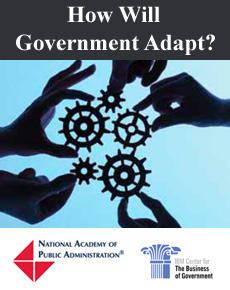
How Will Government Adapt?: Reinvigorating the Civil Service

Surveys of college seniors show that only 6 percent would consider entering public service as a career, with only 2.3 percent willing to consider Federal service. What plans and strategies will federal departments and agencies employ to attract Millennials and Gen-Xers to public service over the next decade? What skill sets will employees need? Are departments and agencies prepared for this challenge? What actions will be needed to overcome these obstacles, seize opportunities and reinvigorate the public service? This is the fifth blog post in a series that sums up highlights of selected sessions held as part of the annual meeting in mid-November of the National Academy of Pubic Administration. Panelists The Honorable Dan G. Blair, President and CEO, National Academy of Public Administration Robert M. Tobias, Professor, Public Sector Executive Education, American University Max Stier, President and CEO, Partnership for Public Service John C. Salamone, Vice President, Federal Management Partners Angela Evans, Clinical Professor in Public Policy Practice, LBJ School of Public Affairs, University of Texas Highlights This panel of federal human capital experts examined the grave state the Federal civil service is in and what might be done to reinvigorate it. This complex challenge has many causes and exacerbating factors -- and many possible creative solutions. Out of the many possible causes and many possible solutions discussed, a few key insights stand out: If every organization has a vision and mission statement, what should their federal human capital vison be? The President, in his role as Chief Executive Officer of the federal government, can and should lead the way. The Senior Executive Service needs a thorough reassessment. Policy implementation is critical and civil servants, the implementers of the policy, can enrich and inform the policy discussions. Who speaks for the civil servants? Political champions of the civil servants need to be more vocal and effective. The retirement wave (Baby Boomers eligible to retire) is threatening the capacity of the entire federal civil service system and needs to be systemically addressed. The government is at crisis level in its ability to address its management challenges. The government as an institution is more isolated from the public than ever before. The challenges are becoming more difficult to address and the public’s trust in the federal government to address those challenges is lower than it has ever been. A more nimble, innovative, and resourceful federal civil service is called for. Several programs created to provide a career path for top entry-level talent, like the Pathways and Presidential Management Program, have not preformed up to the designed expectations. There are a lot of bright, enthusiastic people who want to work for the government. We have to make sure the government is doing a good job at getting them in and keeping them. The Government Accountability Office’s internship program was discussed as a potential model to attract and retain workers in other parts of the government. Clearing out the unnecessary “underbrush” in the federal human capital system, especially in Title 5, which governs the federal personnel system, will make addressing these problems easier. (summary prepared by Matt Gripp, NAPA) Visit the landing page of this initiative where you can learn of future blog post topics and follow previous conversations.



